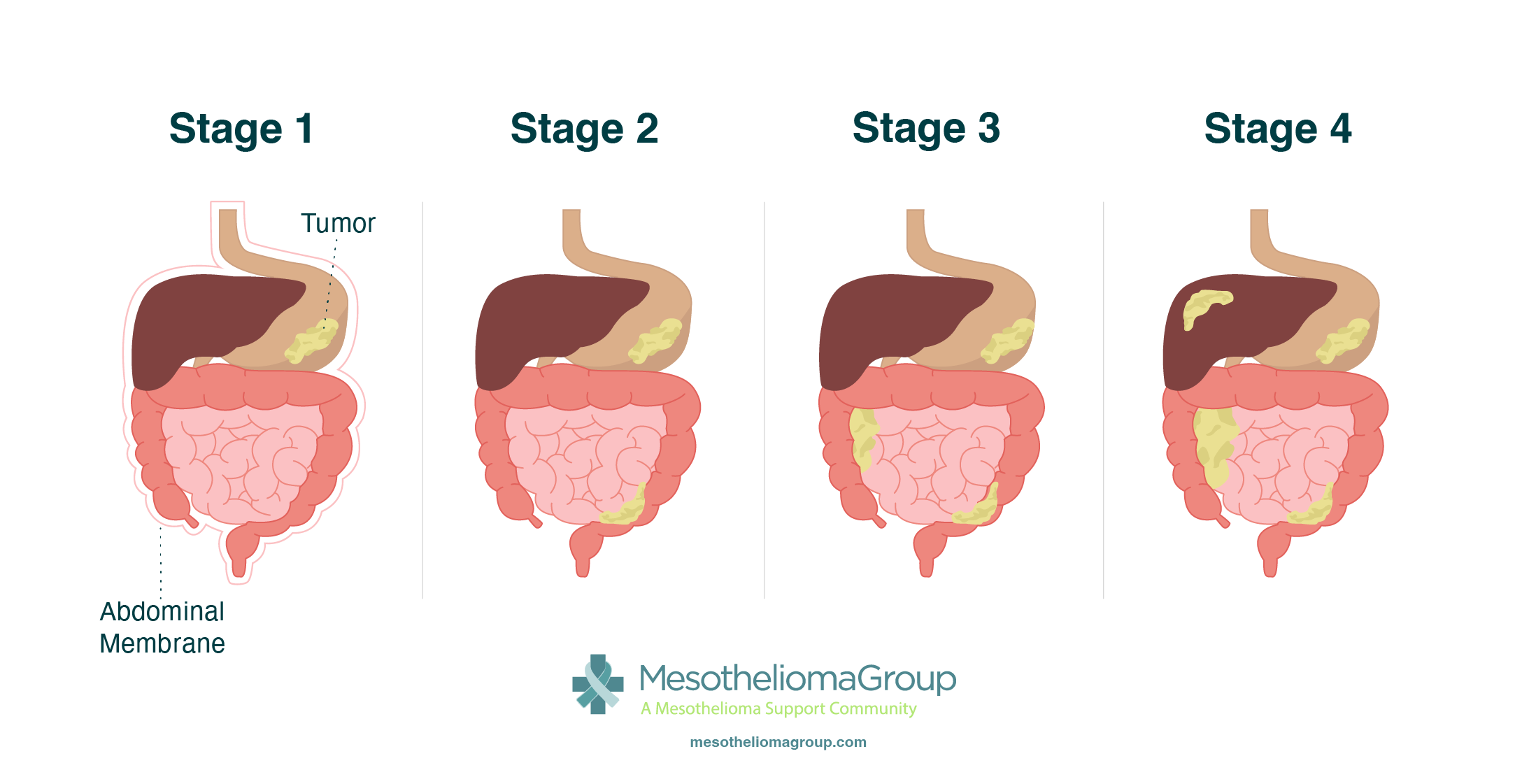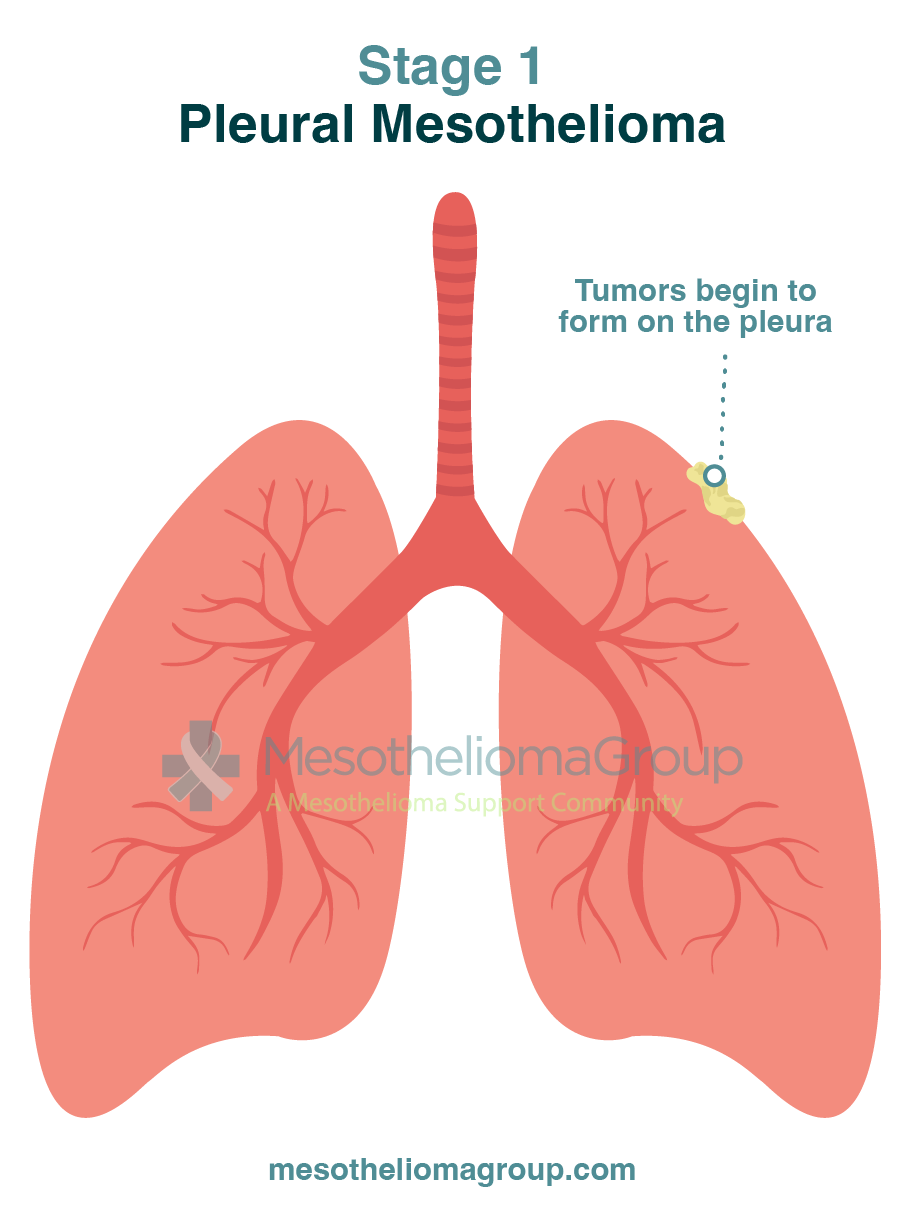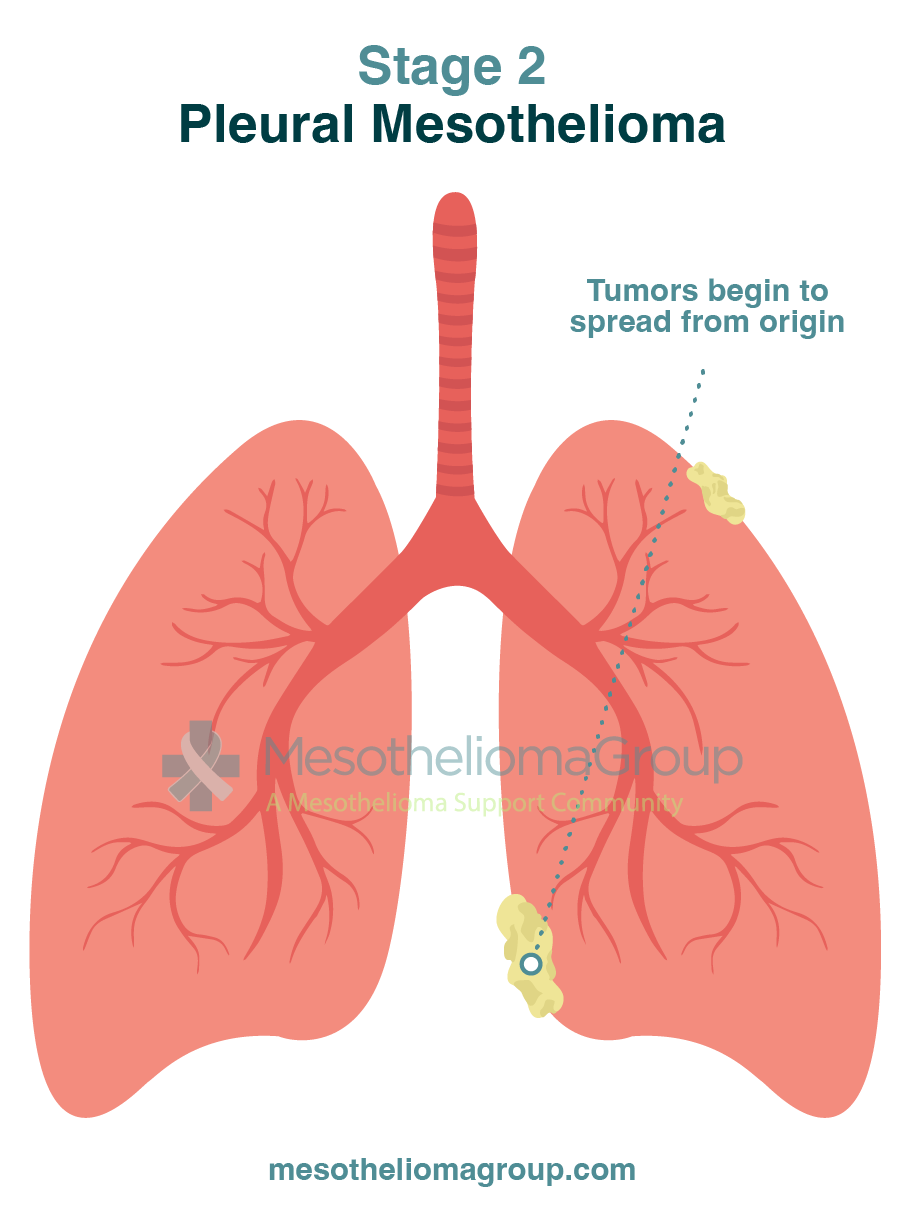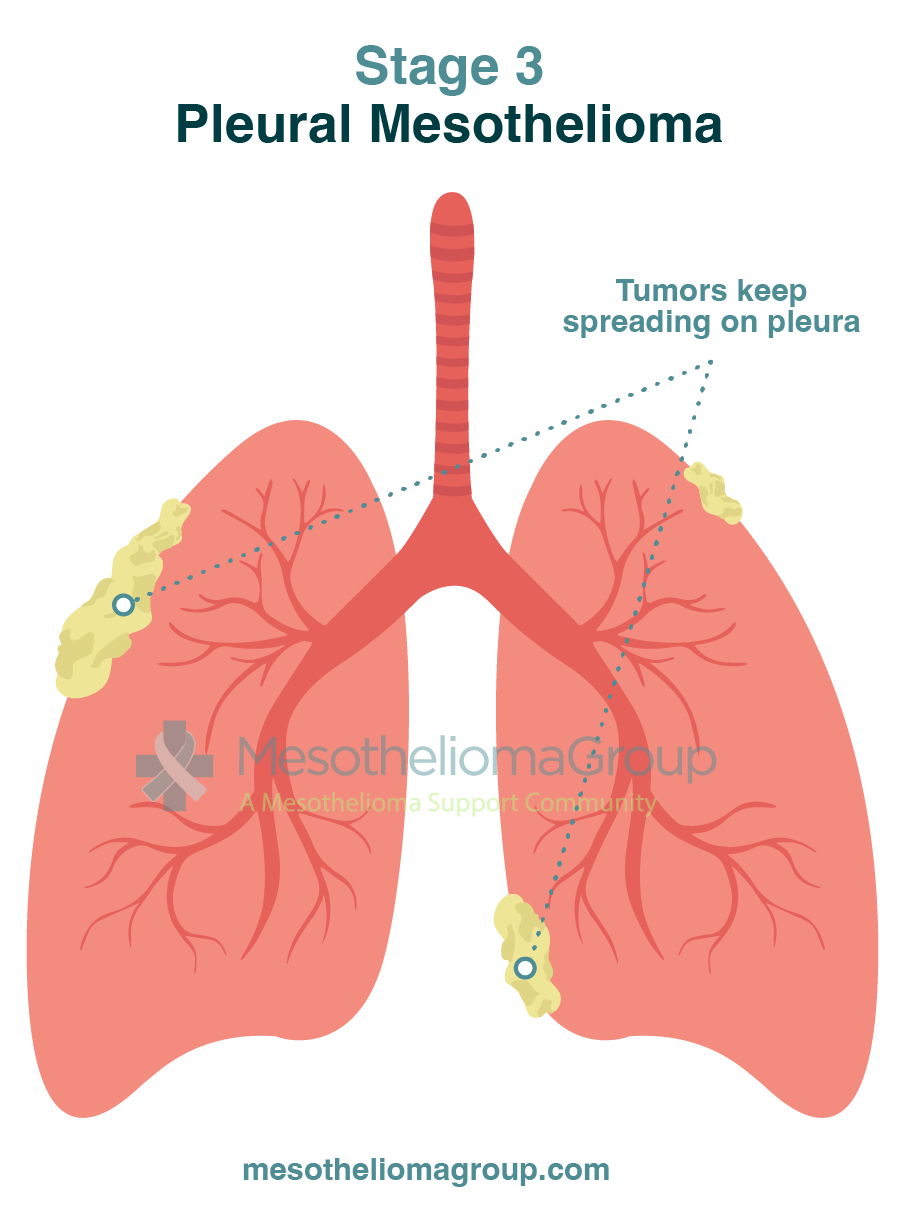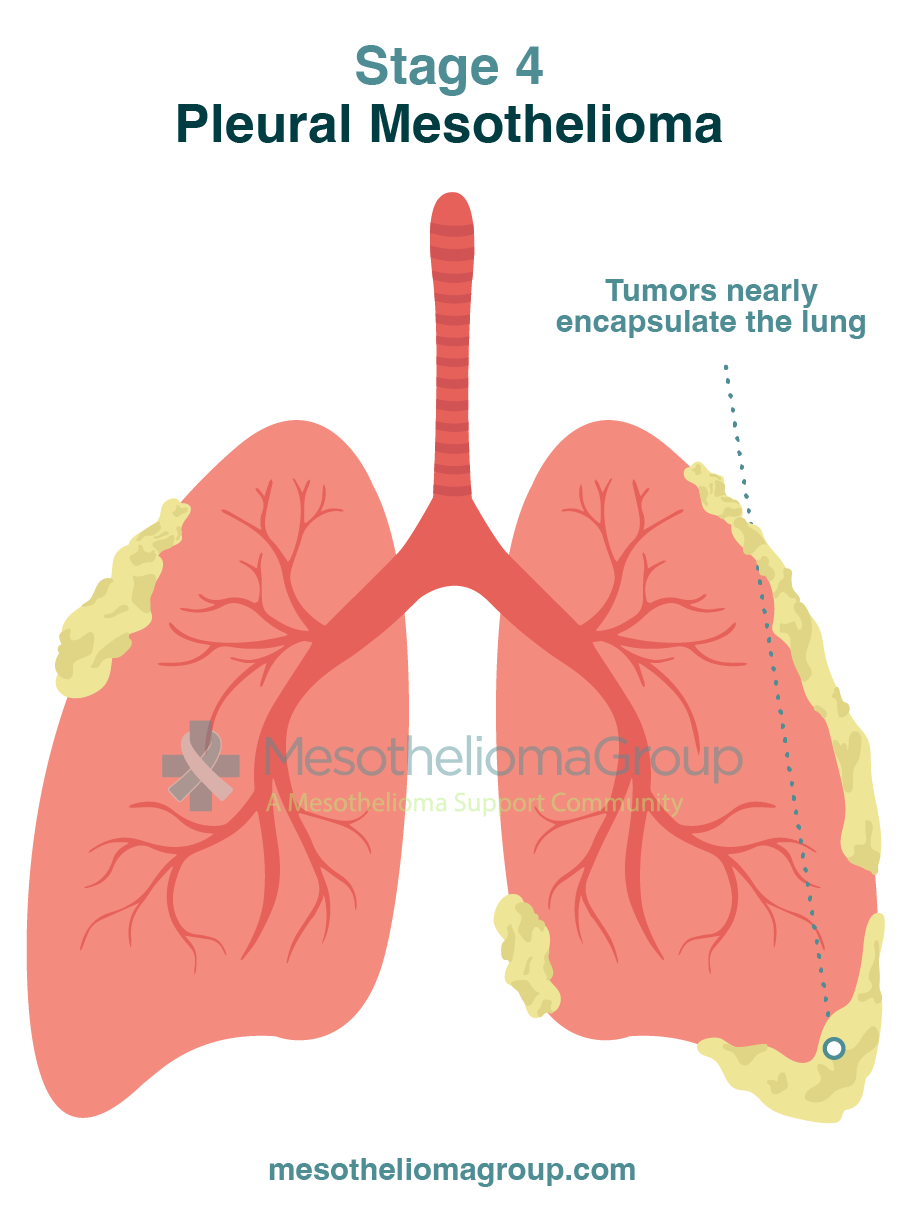Doctors use staging to indicate how far cancer has spread throughout the body because it helps cancer care teams communicate case details and make important treatment decisions for their patients.
What Are the Four Stages of Mesothelioma?
The stage of a mesothelioma tumor describes how far it’s spread (metastasized) from where it first appeared in the protective lining of the lungs, abdomen, or heart. Generally, the farther mesothelioma has spread, the later doctors stage the disease.
Pleural Mesothelioma Stages
It’s important to note that pleural mesothelioma is the only type of mesothelioma that uses the cancer staging system. Other types like peritoneal mesothelioma and pericardial mesothelioma are much rarer than pleural mesothelioma and therefore more difficult to accurately stage.
- Stage 1: There’s no spread to lymph nodes and the cancer is localized to one side of the body. This is the earliest stage. Stage 1 patients have the most treatment options.
- Stage 2: Mesothelioma is still localized to one side of the body but there are signs of metastasis to nearby lymph nodes. Aggressive treatments are still an option.
- Stage 3: The first significant signs of metastasis have occurred. Mesothelioma has spread to lymph nodes and surrounding organs. Surgical options become limited.
- Stage 4: Mesothelioma has spread throughout the chest wall, pericardium, and diaphragm. Treatment options for stage 4 patients primarily involve relieving symptoms.
What Mesothelioma Cancer Staging Can Tell You
Mesothelioma staging helps oncologists identify the best treatment plan based on how far the disease has spread from the pleura, the protective lining of the lungs. Early-stage mesothelioma, in which the disease has spread less, includes stages 1 and 2, while advanced-stage includes stages 3 and 4.
Doctors may use lab tests, imaging, biopsies and other methods to determine the stage.
Stage 1 Pleural Mesothelioma
The growth of stage 1 pleural mesothelioma is limited to one side of the chest where tumors develop in the pleural lining of one lung. The pleural lining is the thin membrane that lines your lungs, chest and diaphragm and divides the abdomen from the chest cavity.
During stage 1, the tumor can also spread from the outer lining of the lung (closer to the wall of your chest) to the inner lining (closer to the lung itself).
Patients diagnosed with stage 1 mesothelioma have the most favorable prognosis compared to more advanced stages of the disease. Stage 1 tumors are more responsive to curative treatment—like surgery, chemotherapy, or radiation therapy—because the tumor is limited to the lining of one lung and easier for doctors to remove.
Stage 2 Pleural Mesothelioma
Like stage 1, most of the growth of a stage 2 tumor still occurs in the lining of one lung. At this point, however, the cancer cells may have spread to the walls of the patient's chest, diaphragm, nearby lymph nodes, or to the lung itself.
Patients diagnosed with stage 2 pleural mesothelioma have a similar prognosis to patients with stage 1. Stage 2 patients are still eligible for curative treatments that can extend life expectancy.
Stage 3 Pleural Mesothelioma
At stage 3, a tumor has spread throughout one side of the body to nearby tissues,
invading at least one—or all—of the following: one lung, the diaphragm, nearby lymph nodes, and the protective lining of the heart.
The prognosis of patients diagnosed with stage 3 mesothelioma is closely linked to age and general health. Those who are healthy, and can withstand surgery, may be eligible for treatments that can extend life expectancy well past the average. Surgery is generally not an option for Stage 3 pleural mesothelioma.
Stage 4 Pleural Mesothelioma
The growth of a stage 4 mesothelioma
tumor has spread far beyond the lining of one lung. At this stage, cancer cells and secondary tumors may exist in larger sections of the chest wall, diaphragm, lining of the heart, and lymph nodes located far from the lining of the lung.
Patients diagnosed with stage 4 mesothelioma may have an average life expectancy shorter than 12 months. Stage 4 patients may not be eligible for traditional curative treatment options like surgery. Patients do, however, have other options. Palliative treatments ease pain caused by the disease and have shown prognostic benefits in some cases.
Patients can also speak with their doctors about new treatments that researchers are testing in clinical trials. Some experimental therapies currently in clinical trials may become standard treatments and may lead to a cure in the future.
Discover How You Can Beat The Odds
Get your free mesothelioma guide and learn about your treatment options.
Get My Free GuideHow Doctors Determine Mesothelioma Stages
Doctors use imaging tests and biopsies to visually confirm how far mesothelioma has spread. The results of your diagnosis help them decide which treatments fit your needs, and which will have the most positive impact on your prognosis.
Each type of scan provides them with visual information on the growth and spread of a tumor; information they use to determine the cancer stage of the mesothelioma:
- CT Scan: A computed tomography (CT) scan generates several X-ray images doctors put together to make a single 3D image of the chest or stomach. Doctors use CT scans to determine if a tumor has spread to the chest wall or diaphragm.
- MRI Scan: Doctors use a magnetic resonance imaging (MRI) scan to find out if mesothelioma has spread from the lining of the lungs (the pleura) to the chest wall, lining of the heart, or nearby organs.
- Positron Emission Tomography (PET) Scan: A PET scan is often considered to be the best method to determine if mesothelioma has spread to other parts of the body. Doctors can even use it to find out if a tumor has spread to lymph nodes that are far from where the mesothelioma first appeared.
Staging Systems for Mesothelioma
Doctors use three staging-systems to describe the spread of mesothelioma. These systems weren’t specifically made for Mesothelioma though and are more often used to stage other lung cancers. Nevertheless, they help doctors determine how far a tumor has spread, and how possible certain treatment options are. Each system focuses on a different aspect of metastasis, but they all divide it into 4 stages.
TNM System
The American Joint Committee on Cancer (AJCC) and the International Union Against Cancer (UICC) worked together to create the TNM (tumor, nodes, metastasis) system. The TNM system evaluates the growth of the primary tumor and how much it has spread to lymph nodes and other organs. This system, which is also known as the AJCC staging system, is the most common staging systems used by hospitals and health systems for reporting.
The TNM staging system emphasizes three main factors regarding the advancement and spread of pleural mesothelioma, according to the AJCC Cancer Staging Manual:
- T refers to the growth of the primary tumor.
- N refers to the extent the tumor has spread to nearby lymph nodes.
- M refers to the tumor’s spread to other organs.
The TNM staging system assigns numbers to each factor to describe metastasis in more detail.
After they categorize a tumor according to each individual group—T, N, and M—doctors assign it an overall stage. They assign the overall stage by combining the tumor’s T, N, and M values. A lower stage number means the tumor hasn’t spread far.
Stage 1
Cancer is only in one layer of the lung’s lining (pleura) and may have spread to the lining of the heart or diaphragm.
Stage 2
Cancer has spread through the rest of the pleura’s layers and possibly to nearby lymph nodes but is only on one side of the body.
Stage 3
Cancer has spread to other areas like the chest wall, esophagus, diaphragm, and lymph nodes on both sides of the body.
Stage 4
Traveling through the bloodstream, cancer has spread throughout the body and may affect organs like the brain, liver, or bones.
Brigham System
The Brigham and Women’s Hospital tumor staging system was developed by Dr. David Sugarbaker at its namesake hospital in collaboration with the Dana-Farber Cancer Institute. Through this system, which is fast becoming a more common tool for pinpointing different factors, doctors can determine if a patient is eligible for surgery.
The Brigham system divides pleural mesothelioma into four stages:
Stage 1
The tumor has not spread to the lymph nodes and can be removed via surgery.
Stage 2
The tumor has not spread to the lymph nodes and can be removed via surgery.
Stage 3
The tumor has spread to nearby organs and body structures, such as the pericardium, chest wall, peritoneum, and diaphragm. Surgery is no longer an option.
Stage 4
The tumor has spread to areas and organs far outside where the tumor first appeared. Surgery is no longer an option.
Butchart System
Developed by Dr. Eric Butchart in the 1970s, the Butchart system is the oldest method of classifying pleural mesothelioma and is used exclusively for this disease. While its use has become less common as other staging systems have developed, the system is still sometimes used today to identify the location of the main tumor, rather than how large it is or how far it has spread.
Stage 1
The tumor is in the lining of one lung and may have spread to the lining of the heart or diaphragm. In the Butchart system, this is the stage where doctors can most effectively remove the tumor.
Stage 2
The tumor has spread to the chest wall and may have grown into the inner part of the lung’s lining. At this stage, it’s also possible that mesothelioma cells are present in the esophagus, heart, and lymph nodes surrounding the chest.
Stage 3
The tumor has spread from the lining of the lung to the diaphragm or lining of the abdomen. Cells may have spread into lymph nodes far from the main tumor. Curative surgery is no longer a good option, and palliative treatment may be the main form of treatment.
Stage 4
Cancer cells have spread through the bloodstream to areas far from the main tumor. Palliative treatments are now the only available course of treatment.
Metastatic Symptoms for Malignant Pleural Mesothelioma
Symptoms caused by the spread of mesothelioma are metastatic. As a tumor grows, you’ll feel more symptoms, and they’ll happen more often. Doctors divide metastatic symptoms into two general categories: early-stage and advanced-stage. Generally speaking, early-stage symptoms cover symptoms caused by stage 1 and stage 2 mesothelioma while advanced-stage involves stages 3 and 4.
In the early stages of metastasis, symptoms of pleural mesothelioma will feel like those caused by other illnesses of the lungs, such as pneumonia or asthma. Symptoms caused by advanced-stage mesothelioma happen more often and are more specific than those caused by early-stage mesothelioma.
Early-Stage Symptoms
- Difficulty breathing
- Persistent coughing
- Fatigue
- Chest pain
- Fever
- Weight loss
Advanced Stage Symptoms
- Hemoptysis, or the coughing up of blood
- Dysphagia, or difficulty swallowing
- Increased fatigue
- Pleural effusions
- Fever
- Night sweats
Peritoneal and Pericardial Mesothelioma Staging
Peritoneal and pericardial mesothelioma are both rare relative to pleural mesothelioma, which accounts for about 75 percent of all cases. So, doctors don’t see enough cases of peritoneal or pericardial mesothelioma to accurately describe them using stages.
Patients with peritoneal or pericardial mesothelioma are generally described as having localized or advanced mesothelioma. An experienced doctor can still assess how far the mesothelioma has spread and which treatments will work best to improve prognosis.
How Doctors Assess Peritoneal Mesothelioma
Oncologists may use the peritoneal cancer index (PCI), the most common system to stage peritoneal mesothelioma, to determine disease progression.
PCI is done by dividing the abdomen into sections. An oncologist will check for cancer in each section and assign a number (0-3) based on if cancer is present. The doctor will then add the numbers to determine the stage. Like other systems, stage 1 indicates less advanced cancer, while stage 4 indicates more advanced cancer.
PCI score ranges for each stage are:
- 1-10 for stage 1
- 11-20 for stage 2
- 22-30 for stage 3
- 31-39 for stage 4
How Doctors Assess Pericardial Mesothelioma
Pericardial mesothelioma, an aggressive form of cancer, is extremely rare with only 200 reported cases described in medical literature. As a result, there is no formal staging system for pericardial mesothelioma. Oncologists may use more general stages to describe the cancer’s progression, but there is limited understanding of disease progression given how few cases have been reported.
Why Cancer Staging is Important
Doctors use the cancer stage of mesothelioma to determine which treatment options are available, and how effective those options will be.
If you’ve been diagnosed with early-stage mesothelioma, you’re most likely eligible for traditional treatments—surgery, chemotherapy, radiation therapy—that can extend your life expectancy. However, if you’ve been diagnosed with advanced-stage mesothelioma, traditional treatments may not be an option although you can participate in clinical trials where researchers are testing newer treatments. Treatments like immunotherapy and chemotherapy may be used to extend life expectancy.
How Mesothelioma Stages Inform Treatment Options
Diagnosis at an early stage of pleural mesothelioma means a higher chance of survival. Mesothelioma diagnosed in its early stages, for example, often has a better prognosis with more treatment options available, including surgery and radiation therapy. Later stages may include life-extending treatments, such as chemotherapy to shrink the tumor, or palliative care options.
Stage 1 Mesothelioma Treatment & Prognosis
Patients diagnosed with stage 1 mesothelioma have the best prognosis with many treatment options, including surgery to remove the localized tumor which has not spread and targeted radiation therapy.
The five-year survival rate for localized (stage 1) pleural mesothelioma, according to the American Cancer Society, is 20 percent. And for peritoneal mesothelioma, isolated to the abdominal cavity, the survival rate is much higher.
Stage 2 Mesothelioma Treatment & Prognosis
For patients diagnosed with stage 2 mesothelioma, the prognosis remains good and most surgical treatment are still an option. Oncologists may also recommend chemotherapy or radiation therapy.
The five-year survival rate for regional (stage 2-4) pleural mesothelioma is roughly 16 percent according to the American Cancer Society.
Stage 3 Mesothelioma Treatment & Prognosis
Stage 3 mesothelioma has a poor prognosis given limited treatment options. For later malignant mesothelioma stages, cancer care may include life-extending options like chemotherapy to shrink tumors. Emerging therapies, like immunotherapy, can also be options at this stage.
According to the American Cancer Society, the five-year survival rate for regional (stage 2-4) pleural mesothelioma is around 16 percent.
Stage 4 Mesothelioma Treatment & Prognosis
Given the spread of cancer to distant organs, the prognosis for stage 4 mesothelioma is poor. Stage 4 patients may benefit from clinical trials or palliative care, but chemotherapy is the standard life-extending treatment for patients with late-stage disease.
The five-year survival rate is 16 percent for regional (including some stage 4) and 8 percent for distant (advanced stage 4) pleural mesothelioma, according to the American Cancer Society.
Let us help
As a patient diagnosed with mesothelioma, it’s important to know that you’re getting the best, most effective treatment possible. The key to effective treatment is a correct diagnosis; factors like the cancer stage, cell type, and location of the mesothelioma all play an important role in this respect. If you haven’t already, it’s crucial you get a second opinion from an experienced doctor. Our Patient Help Team can review your diagnosis, connect you with an experienced specialist, and can even help direct you or provide direction so you can get financial aid to pay for treatment. Let us help — for free.
Mesothelioma Staging FAQs
How quickly does mesothelioma progress?
Disease can take decades to appear following asbestos exposure. But late-stage (3-4) disease tends to progress quickly. Certain cell types, like sarcomatoid and biphasic mesotheliomas, are very aggressive and metastasize to other areas of the body quickly. Other cell types like epithelioid mesothelioma, are less aggressive.
What happens in the final stages of mesothelioma?
The final stages of mesothelioma tend to have painful symptoms, including fatigue, weight loss, decreased concentration, slower breathing, confusion, loss of bladder control, hallucinations and loss of consciousness. Palliative care can help to increase comfort during these final stages.
What are the symptoms of advanced mesothelioma?
Mesothelioma diagnosis may come at later stages when certain symptoms appear. Symptoms of stage 4 mesothelioma include:
- Chest pain
- Difficulty swallowing
- Fatigue
- Night sweats
- Painful coughing (including coughing up blood)
- Shortness of breath
- Unexplained weight loss
What system is most often used to stage mesothelioma?
The TNM system (also known as the AJCC staging system) is the most used system by hospitals and health systems to stage mesothelioma. The TNM system evaluates the growth of the primary tumor and how much it has spread to lymph nodes and other organs.
How do I get more information or support?
To learn more about mesothelioma or to find information on cancer treatment, contact Mesothelioma Group at (800) 333-8975.



